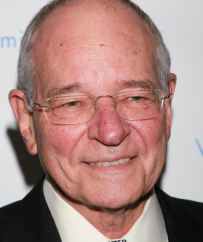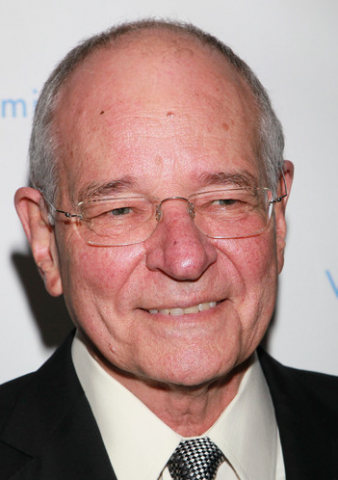Can a football stadium be environmentally friendly? Despite Governor Brown signing bills granting CEQA reform, the question remains. TPR presents the following excerpts from Warren Olney’s KCRW radio show, Which Way, L.A.? featuring Sen. Alex Padilla (D-Pacioma) and David Pettit, Director of the Southern California Air Program with the NRDC. Today, AB 900 and SB 292 are law. But the debate leading to this point illustrates continued uncertainty.

Warren Olney
"We have a framework that, in my opinion, doesn't just expedite the judicial review process but actually strengthens the environmental requirements that this project is going to have to meet." -Senator Alex Padilla, District 20, D-Pacioma
 Warren Olney (Host, KCRW Which Way, L.A.?): Can a football stadium be environmentally friendly? With just four days left in this year’s legislative session, it’s jobs and the environment again in Sacramento. The pressure is on for the Assembly and Senate to approve demands for the proposed NFL stadium in Downtown L.A. Developer AEG wants relief from environmental timetables. Environmentalists warn of gridlock, dirty air and a rush to judgment. Or do they?
Warren Olney (Host, KCRW Which Way, L.A.?): Can a football stadium be environmentally friendly? With just four days left in this year’s legislative session, it’s jobs and the environment again in Sacramento. The pressure is on for the Assembly and Senate to approve demands for the proposed NFL stadium in Downtown L.A. Developer AEG wants relief from environmental timetables. Environmentalists warn of gridlock, dirty air and a rush to judgment. Or do they?
The developer AEG is demanding special relief from state environmental procedures as a condition for building an NFL stadium in Downtown L.A. They would still have to complete an environmental impact report, and challenges could still be filed in court. But AEG wants to speed up the process. The stadium has not been fully approved, but AEG wants action in Sacramento now, before this year’s legislative session ends on Friday. Alex Padilla is a Democratic State Senator from Los Angeles. His district includes much of the San Fernando Valley. He’s one of the many sponsors of the AEG bill. Senator, it’s good to have you on our program.
 Alex Padilla (California State Senator, District 20, D-Pacioma): Good afternoon. Thanks for having me.
Alex Padilla (California State Senator, District 20, D-Pacioma): Good afternoon. Thanks for having me.
Warren Olney: What’s the rush?
Senator Padilla: The urgency is 99 percent driven by the unemployment rate that we have. We know that our state, in fact our nation, has struggled to create those jobs, jobs, jobs that we hear about from leaders in Washington, D.C. to Sacramento to the city of Los Angeles and everywhere in between. Here we have before us an opportunity to green-light a project that can directly lead to 10,000 or more construction jobs as a result—these are good-paying jobs—and when completed will lead to more than 10,000 permanent jobs between the convention center, the stadium, and the entire entertainment district. This, by the way, would be done with 100 percent private investment. For the better part of the past decade, if not longer, any time we talked about a sports facility or an entertainment facility the question was always focused on public subsidies. How much would the city, the county, the state put into the deal? Here we have a developer willing to do this on their own dime, at a time when we can surely use the jobs. So we’ve got to embrace this opportunity and be of assistance, not an impediment.
Warren Olney: But the NFL hasn’t even said it would play there.
Senator Padilla: That’s a great point. I know here in the hallways of the state capital there is a little bit of beneath the surface chatter about Los Angeles versus what happened to the City of Industry proposal from a couple of years ago. I’m hearing from my colleagues from San Diego about their concerns about the Chargers moving. I want to be clear about something:it’s not going to be the governor or the legislature who determine where our stadium is ultimately built, or where a team moves. It’s not the Mayor or anyone at city hall, with all due respect to him. The NFL is going to decide that.
The question before the legislature truly is this: do we encourage one, or more than one, proposal to be viably presented to the NFL for their choice to make. Personally, I think that the scale and the magnitude of what is possible downtown, between not just the stadium but the stadium, the convention center, the hotels to come, and the whole entertainment complex—I think the opportunity for that massive scale of job-creation, investment, and economic stimulus is something that couldn’t have come at a better time.
Warren Olney: Mr. Pettit, in a press release, you said this about the bill that the senator is talking about: “The legislature can do more to prevent gridlock and dirty air without a rush to judgment.” What did you mean by that?
 David Pettit (Director of the Souther California Air Program, Natural Resources Defense Council): Let me back up a minute and say that I agree with everything that Senator Padilla just said. I want the stadium to get built. NRDC isn’t trying to kill it; we’re trying to make it work. One of the problems that we have is that the bill, as written, gives AEG a litigation benefit that no other litigant in California has. In return I think that we, the people of L.A., need to get something for that. I have some language concerns about the bill. I should say that right now I am literally standing in the halls of the capital building and on my way to another meeting to try to work out some language that I think gets everyone where we want to go.
David Pettit (Director of the Souther California Air Program, Natural Resources Defense Council): Let me back up a minute and say that I agree with everything that Senator Padilla just said. I want the stadium to get built. NRDC isn’t trying to kill it; we’re trying to make it work. One of the problems that we have is that the bill, as written, gives AEG a litigation benefit that no other litigant in California has. In return I think that we, the people of L.A., need to get something for that. I have some language concerns about the bill. I should say that right now I am literally standing in the halls of the capital building and on my way to another meeting to try to work out some language that I think gets everyone where we want to go.
Warren Olney: Obviously we are talking about a work in progress. As I understand it, AEG will produce what it describes as the most environmentally sound stadium in the country. Anybody who wants to sue based on environmental concerns goes directly to the appellate court. The appellate court will only have 175 days to make a final decision. Are you concerned that people will have enough time and have enough opportunities to present their grievances in court if they have them?
David Pettit: No, I’m actually not concerned with that. I think I’ll take some heat for that from my environmental colleagues, but if you’ve participated in the EIR and the CEQA process, you’ve already got your arguments lined up. One of the provisions in the bill was actually something that I suggested, which is that the city take administrative steps so that the litigation can get started right away. I think the 175 days thing is unusual but doable.
Warren Olney: Bearing in mind that our listeners will hear this after the hearing has occurred, Senator Padilla, are you willing to modify this?
Senator Padilla: Absolutely. Conversations are continuing 24/7 at this point, given that Friday is the last day of our session. Look, the process is working exactly as it is structured to. It was later in the year than some people would have preferred, but we unveiled our language last Friday. It’s been a three, four day process to get to today, and we got to the process of policy committee hearings for the bill, not just in the Assembly but the Senate, before the full Assembly and Senate vote in their entireties.
We have a framework that, in my opinion, doesn’t just expedite the judicial review process, but actually strengthens the environmental requirements that this project is going to have to meet. At the outset of the program you mentioned that AEG is not seeking an exemption from CEQA. That’s very true, and we need to emphasize that. They have committed to a full Environmental Impact Study and a full Environmental Impact Report. So as the law of California says, any environmental impacts that are identified have to be mitigated. What we’re talking about here is a proposal that would require AEG to go far above and beyond the minimum requirements. This includes unprecedented levels of required use of mass transit (mind you this is Los Angeles, not New York, not Chicago, and not Boston). So in terms of the expedited judicial review, I think there is a lot to like in this proposal if you are concerned about the environment.
Warren Olney: How sure are you that AEG will do what it says it will, and when you talk about people using mass transit that’s up to them, isn’t it? Not up to AEG?
Senator Padilla: It’s up to them, but it could be a condition upon the project if this bill is approved. I have two things to go on Warren, and I’m completely heartfelt about this. One, it’s about how strict we write this language here, because it will become state law and any lack of compliance will be a violation of state law. Two, I’ve worked with AEG, not just as a State Senator but during my days on the city council and as president of the city council. I think the city of Los Angeles knows AEG from both the Staples Center experience and the negotiations on L.A. Live hotel deals. Every commitment that AEG has made to the city government and to the people of Los Angeles they have met and exceeded. They have a wonderful track record, not just from a business standpoint but from an environmental standpoint as well.
Warren Olney: But this issue of mass transit and the law, and how strict you write the language, you wouldn’t require people who go to the games to ride on mass transit, would you?
Senator Padilla: Well it’s not just mass transit. It could be shuttles, it could be walking in. With all the hotels and all the attractions that downtown now has that draw visitors from around the state, around the country, and around the world, there will be healthy number of people who will walk into the stadium. The fact that it is a stadium facility that could be utilized in conjunction with major conventions under a revitalized convention center would mean that there are a lot of convention attendees who could participate as fans or as attendees of a football game.
This metric of what percentage of the fans at a football game got there in a private vehicle versus got there on some form of alternative transportation is a metric that isn’t made at any football stadium in America today. What we’re laying the groundwork for is that we are going to start measuring every NFL game in the country, and Los Angeles will have to surpass that by no less than ten percent. That’s the kind of ambitious goals we are laying out in my bill.
Warren Olney: David Pettit, is that enforceable?
David Pettit: That’s what we are talking about. I want to make sure that there are metrics in there that are enforceable. We’ve suggested things like having a game-day ticket be a free pass on Metro. They do that sometimes at the Super Bowl. By the time the stadium is built, the Expo line is going to run all the way to Santa Monica, where I live, and we are going to have all kinds of expanded public transit. I would love to be able to take light rail to the game. That way I’d be able to drink all the beer I want and then take the train home. It would be great. The details about how we are going to enforce this and the time periods that we are talking about are in discussions right now as we are on the radio.
Warren Olney: David Pettit, you said that some of your environmental colleagues are not going to agree with you on this. How much do you expect from them in the way of opposition?
David Pettit: I think that some folks are so wedded to CEQA as it is that any change or tweak in it is going to draw some opposition. I think that—and I will probably draw heat for what I am about to say—we are in the worst economic situation of my lifetime. The unemployment rate in Los Angeles is over 12 percent. So sometimes I think we need to bend a little on the old ways and the established wisdom to deal with the economic reality. When I first saw this proposal I thought, “this could be a win for everyone.” We get football back, we get a lot of well-paid jobs, and we get an infill project that is accessible to public transit. We just need to make sure that we do it right.
- Log in to post comments



